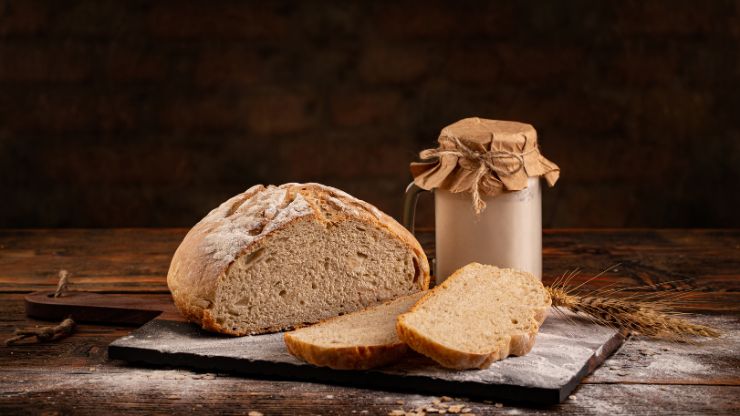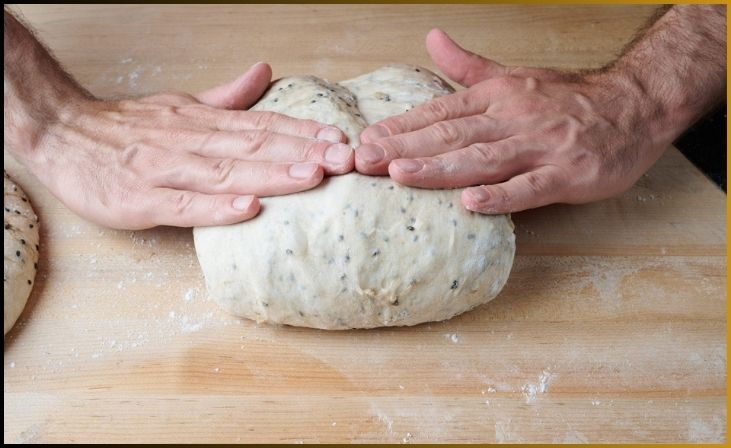In a world filled with intricate culinary creations and gourmet delights, there’s an enduring charm in the simplicity of a loaf of Plain ‘Ole Sourdough Bread. This humble bread, with its crusty exterior and chewy crumb, carries with it the essence of timeless traditions and the soul-warming comfort of homemade goodness. While artisanal bread variations abound, the basic sourdough remains an irreplaceable staple for many, embodying the heart and history of bread-making.
In this blog, we’ll delve into the art of crafting this beloved classic, exploring the fundamental steps that transform a handful of basic ingredients into a loaf that’s not only delicious but also rich in tradition. From mixing and fermenting to shaping, proofing, and finally baking, we’ll guide you through the journey of creating your very own Plain ‘Ole Sourdough Bread, celebrating the beauty of simplicity and the joy of baking from scratch.
Table of Contents
ToggleThe Essence of Basic Sourdough

What makes basic sourdough bread so appealing, and why has it been cherished for generations? To understand its allure, we must delve into the fundamental aspects of this bread, from the ingredients to the process.
Ingredients That Matter
- Flour: The quality of your flour is paramount. Choose a high-quality bread flour, whole wheat flour, or a mixture of both. Each type brings a unique flavor and texture to your bread.
- Water: The other key ingredient, water, should be chlorine-free. Water activates the wild yeast and begins the process of fermentation.
- Salt: Not just a flavor enhancer, salt regulates the fermentation process, giving you control over the rise of your bread.
- Sourdough Starter: This is the heart and soul of your bread. It’s a living culture of wild yeast and lactic acid bacteria that ferments the dough.
Also Read- Whole Wheat Brownie Sourdough Bread
The Process of Creation
Sourdough bread-making is as much an art as it is a science. It involves several essential steps:
Mixing
Mixing in the process of making basic sourdough bread is a pivotal step where the key ingredients—flour, water, and sourdough starter—unite. During mixing, the flour absorbs the water, initiating the gluten formation and hydrating the starches. This phase is not about vigorous kneading; instead, it’s about creating a cohesive, shaggy dough. It’s crucial not to rush this step, as allowing the dough to rest helps ensure even hydration and sets the stage for the magic of fermentation.
As you mix, the wild yeast from the starter awakens, beginning its work of converting flour’s sugars into carbon dioxide, which will eventually leaven the bread, giving it its signature airy texture and complex flavor.
Bulk Fermentation
Bulk fermentation is a crucial stage in the basic sourdough bread-making process. During this phase, the dough undergoes significant transformation as it ferments in a bulk mass. Wild yeast and lactic acid bacteria from the sourdough starter work diligently to leaven and flavor the dough. This period of fermentation, typically lasting several hours, allows the dough to increase in volume, develop its characteristic open crumb structure, and attain its unique, tangy taste.
It’s a delicate balance of time and temperature, as the dough should be left undisturbed to ferment but monitored to avoid over-fermentation. The bulk fermentation stage is where the dough comes alive, and its flavor and texture mature, setting the stage for the final shaping and baking of a delicious homemade sourdough loaf.
Shaping

Shaping in the context of basic sourdough bread-making is the art of transforming the fermented dough into its final, recognizable form. This crucial step involves gently pre-shaping the dough into a round or oval shape, which is then allowed to rest briefly.
Don't just scroll, subscribe!
BuzzTrail's unique web-stories are the cure for boredom you've been waiting for.
Afterward, the dough is given its definitive shape, whether it’s a boule (round loaf) or batard (oval loaf), with proper surface tension for a well-structured final product. Shaping isn’t merely about aesthetics; it influences the bread’s oven spring, crumb structure, and crust. It’s a skill that improves with practice and is essential for achieving the desired outcome in a beautifully crafted, homemade sourdough bread.
Final Proof
The final proof is the last stage in the process of making basic sourdough bread, where the shaped dough undergoes its final rise before baking. During this stage, the dough rests at a controlled temperature and humidity, allowing it to expand and develop its airy structure. The natural fermentation process, initiated by the wild yeast and lactic acid bacteria in the sourdough starter, continues to create gas, leavening the dough and enhancing its flavor.
The final proof is a critical step, as it determines the bread’s final size, texture, and crumb structure. Proper timing and conditions are essential to achieve the desired results, ensuring a beautifully risen and flavorful sourdough loaf.
Baking
Baking in the context of basic sourdough bread-making is the culmination of a patient and skillful process. The shaped and proofed dough is placed into a preheated oven, where it undergoes a magical transformation. The initial burst of high heat creates oven spring, causing the bread to rise and develop a crust. As the baking continues at a lower temperature, the crust deepens in color and texture, while the crumb inside sets, creating a tender, open structure.
The heat catalyzes the Maillard reaction, which contributes to the bread’s flavor and aroma. This stage is a culmination of precise timing, temperature, and technique, resulting in a beautifully baked, homemade sourdough loaf that’s crusty on the outside and tender on the inside.
Cooling
Cooling is the final act in the theater of basic sourdough bread-making, and it’s an often-overlooked but vital step in achieving the perfect loaf. As the freshly baked bread emerges from the oven, it’s still undergoing subtle transformations. During the cooling phase, the bread’s residual internal heat distributes evenly, finishing the cooking process, and ensuring that the crumb structure sets properly.
A good cool-down also stabilizes the moisture within the bread, preventing it from becoming too gummy. It’s recommended to place the bread on a wire rack to allow for proper airflow, which helps maintain the desired crust texture. While it may be tempting to dive right into a warm loaf, allowing it to cool completely before slicing is the secret to preserving the bread’s texture and flavor.
Also Read- Cheesy Whole-Wheat Sourdough Bread
Conclusion
The Plain ‘Ole, Basic Sourdough Bread is a timeless classic that encapsulates the heart and soul of sourdough baking. It’s a bread rooted in tradition, crafted through fermentation, and celebrated for its simplicity. Each slice offers a taste of history, a bite of artisanal craftsmanship, and a reminder of the joy of homemade bread. Whether you’re a seasoned baker or new to the world of sourdough, this bread will always have a place at your table, ready to be enjoyed plain, toasted, or paired with your favorite dishes.
FAQs
What is the sourdough starter, and how do I create one?
What is the sourdough starter, and how do I create one?
A sourdough starter is a mixture of flour and water that captures wild yeast and bacteria from the environment. To create one, combine equal parts of flour and water in a jar, and let it ferment, feeding it daily until it becomes bubbly and active. This process can take up to a week or longer.
Can I use whole wheat flour exclusively for my basic sourdough bread?
Can I use whole wheat flour exclusively for my basic sourdough bread?
Yes, you can use whole wheat flour exclusively, but it may result in a denser loaf. Many bakers prefer a mixture of bread flour and whole wheat for a balanced texture and flavor.
Do I have to knead the dough for basic sourdough bread?
Do I have to knead the dough for basic sourdough bread?
No, traditional sourdough recipes often employ the stretch-and-fold method during bulk fermentation instead of kneading. This helps develop the dough’s structure without excessive kneading.
How can I ensure my bread has a good rise during baking?
How can I ensure my bread has a good rise during baking?
Achieving a good rise depends on factors like the strength of your starter, bulk fermentation time, and proper shaping. Be sure to follow the recipe closely, and don’t rush the process.

